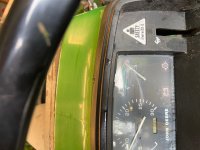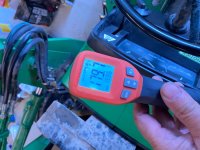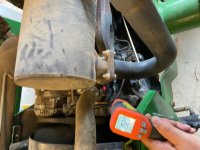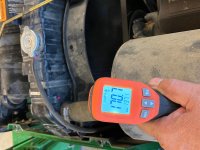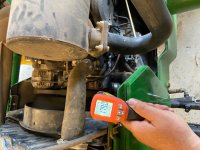How do you test the temperature sender? Ohms? Range? How about replacing it with a fixed resistor to to test the temperature readout?
It may help you to know how the temperature sender works on our older John Deere (2008 model). I'm not saying that this is your problem. Just letting you know that what you are seeing may not be what immediately comes to mind.
On our JD, the temperature sender starts cold at about 5 or 10 ohms and decreases to almost zero as the water temperature goes up. The sender signal goes into the engine computer where it is used to generate a very realistic-looking gauge on the dash. To the operatorin the cab, the gauge on the dash looks like an old-fashioned trustworthy analog gauge - but it isn't. It's a simulation of what a gauge would show at that temperature.
The problem starts as temperature sender's signal comes into the engine computer. It arrives by wire to a 20+ pin connector on the engine computer. Both the connector and the connector's subsequent wiring path into the engine computerare NOT weatherproof even though they are exposed to everything. The problem is then the inevitable corrosion in the connector and the engine computer. This is such a known problem that JD offers an exchange computer and a retrofit mounting kit for approx $5K. Plus shop time. The work must be done in a JD shop that has the computer interface.
Here is how the problem happens as the corrosion in the pin connections, wires, and engine computer grows with time:
First of all, it happens slowly. The corrosion in wire and pin connector causes the resistance that the engine computer sees rises very slowly over time. It can take years. The result is that the engine computer always sees a resistance that is the sum of the sender resistance and the slowly increasing connector corrosion resistance. So the computer then under-reports the actual temperature to the dash gauge. Everything seems fine. In fact, the engine can be cooking, and even losing coolant, but the computer continues to show a normal temperature reading on the dash guage. It may even seem a little low.
Eventually the corrosion that was causing the higher resistance will reach a point where it eats through the wire or causes an open circuit in the pin to socket connection. This is an abrupt change. When that happens, the engine computer suddenly sees no resistance at all. To the computer, seeing zero resistance from the temperature sender means sudden and drastic overheating. The computer gauge suddenly shows a severe overheat condition, throws an emergency overheating code, and sets off an alarm.
Sparky All of this to say that just replacing the sender with another may not get to the problem. In fact, the problem may be electrical and not even related to engine heat at all.... or not.....
First thing is to find out if it really is overheating. When the sequence above happened to our JD, the engine which had always seemed to run a little cool suddenly showed dramatic overheating. But it wasn't, and every test I could think of proved to me that it wasn't.... but I still was unhappy enough with what the gauge was showing to decide to figure it out. That's how I found out the facts above, and it came as a surprise.
enjoy,
rScotty
